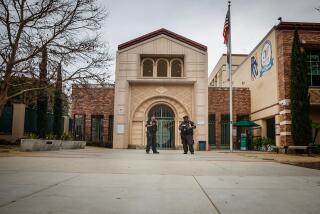Sexual violence common among teens. Feeling responsible isn’t.
Nearly 1 in 10 young Americans between ages 14 and 21 acknowledges having perpetrated an act of sexual violence at least once, and 4% of a nationally representative sample of American kids reported attempting or completing rape, a new study finds.
While those most likely to report initiating unwanted sexual contact in their early to mid-teens were boys, girls were among the perpetrators as the age of respondents increased. Latino and African American youths, and those from low-income families, were less likely to have coerced another person to engage in sex than were whites and those from higher-income families, the study found.
And among perpetrators of sexual violence, consumption of X-rated materials -- specifically those depicting physical harm in the context of sex -- was notably more common than it was among youths who did not report efforts to coerce or force someone else to engage in sex.
The research, published Monday in the journal JAMA Pediatrics, appears to be first to gauge how widespread sexual violence is among Americans of high-school and college age. It was based on surveys conducted between October 2010 and March 2012 with 1,058 people ages 14 to 21 who participated in a broader longitudinal study called “Growing Up With Media.”
Drawing upon the U.S. Justice Department definitions of sexual violence, the authors of the latest research asked participants whether they had ever engaged in a wide range of behaviors, including kissing, touching, making an unwilling partner do something sexual or coercing or forcing someone who did not want to have sex to do so. That range of behavior might range from sexual harassment to rape, but is generally all defined as sexual violence.
In all, 8% of those responding -- 84 of 1,058 respondents -- reported they had kissed, touched or made someone else do something sexual when they knew the person did not want to (characterized as “forced sexual contact”). About 3% reported they had gotten someone else to give in to sex when the perpetrator knew the other person did not want to (characterized as “coercive sex”). Also, 3% acknowledged attempting rape, meaning that he or she had been unable to force someone else to have sex. And 2% -- a total of 18 individuals -- said they had forced another person to have sex when they knew the person did not want to, a completed rape.
Coercive tactics, including arguing, pressuring, getting angry or making someone feel guilty, were most commonly reported by those who acknowledged attempted or completed rape. And the study found that 75% of the cases of sexual violence occurred in the context of a boyfriend-girlfriend relationship. Ten of the respondents -- just under 1% -- acknowledged having threatened or used physical force to get someone to engage in sex.
While vaginal sex was the most common form of forced or coerced sex sought, it was closely followed by oral sex.
The study also found that perpetrators of sexual violence of all types were unlikely to accept responsibility for their acts. One in seven believed that he or she was “not at all responsible for what happened,” and almost 4 in 10 said they considered the victim somewhat or completely responsible for the reported incident. And only two of the respondents reported being arrested for the transgression.
The authors said that the rarity with which perpetrators either are caught or assume responsibility for their actions underscores the importance of “bystander” training and intervention in U.S. high schools and colleges. Such training emphasizes the responsibility of peers not only to discourage and prevent negative behavior within their group or community, but also to recognize, stop or report such behavior when they witness it. Widely used in anti-bullying campaigns, bystander intervention is now gaining ground on college campuses as a means of reducing sexual violence.
The study was conducted by Michele L. Ybarra of the Center for Innovative Public Health Research in San Clemente, CA, and Kimberly Mitchell of the University of New Hampshire’s Crimes Against Children Research Center.
[For the Record, 5:42 p.m. PDT Oct. 7: An earlier online version of this story said the study was based on survey results from 1,062 people; there were 1,058 people.]
Also:
Anti-bullying effort aims at rallying bystanders
Extreme binge drinking common among high school seniors, study finds
HPV vaccination rate stalls. ‘We’re dropping the ball,’ CDC says







